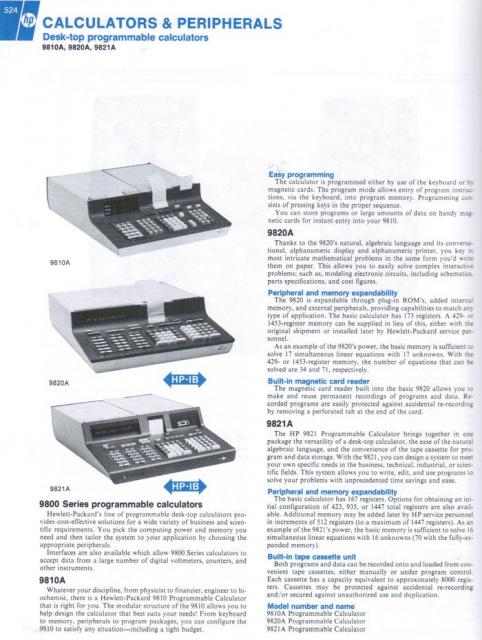
9800 Series programmable calculators
Hewlett-Packard’s line of programmable desk-top calculatorsprovides cost-effective solutions for a wide variety of business and scientificrequirements. You pick the computing power and memory you need and then tailorthe system to your application by choosing the appropriate peripherals.
Interfaces are also available which allow 9800 Seriescalculators to accept data from a large number of digital voltmeters, counters,and other instruments.
9810A
Whatever your discipline, from physicist to financier,engineer to biochemist, there is a Hewlett-Packard 9810 Programmable Calculatorthat is right for you. The modular structure of the 9810 allows you to helpdesign the calculator that best suits your needs! From keyboard to memory,peripherals to program packages, you can configure the 9810 to satisfy anysituation’”including a tight budget.
Easy programming
The calculator is programmed either by use of the keyboardor b magnetic cards. The program mode allows entry of program instructions, viathe keyboard, into program memory. Programming consists of pressing keys in theproper sequence.
You can store programs or large amounts of data on handymagnetic cards for instant entry into your 9810.
9820A
Thanks to the 9820’s natural, algebraic language and itsconversational, alphanumeric display and alphanumeric printer, it allow you toeasily solve complex problems; such as, modelling electronic circuits,including schematics, parts specifications, and cost figures.
Peripheral and memory expandability
The 9820 is expandable through plug-in ROM’s, added internalmemory, and external peripherals, providing capabilities to match an type ofapplication. The basic calculator has 173 registers. A 429- or 1453-registermemory can be supplied in lieu of this, either with the original shipment orinstalled later by Hewlett-Packard service personnel.
As an example of the 9820’s power, the basic memory issufficient to solve 17 simultaneous linear equations with 17 unknowns. With the 429 or 1453 register memory, the number of equations that can be solved are 34 and 71, respectively.
Built-in magnetic card reader
The magnetic card reader built into the basic 9820 allowsyou to make and reuse permanent recordings of programs and data. Recordedprograms are easily protected against accidental re-recording by removing aperforated tab at the end of the card.
9821A
The HP 9821 Programmable Calculator brings together in onepackage the versatility of a desk-top calculator, the ease of the naturalalgebraic language. and the convenience of the tape cassette for program anddata storage. With the 9821, you can design a system to meet your own specificneeds in the business, technical, industrial, or scientific fields. This systemallows you to write, edit, and use programs to solve your problems withunprecedented time savings and ease.
Peripheral and memory expandability
The basic calculator has 167 registers. Options forobtaining an initial configuration of 423. 935, or 1447 total registers arealso available. Additional memory may be added later by HP service personnel inincrements of 512 registers (to a maximum of 1447 registers). As an example ofthe 982 I’s power, the basic memory is sufficient to solve 16 simultaneouslinear equations with 16 unknowns (70 with the fully-expanded memory).
Built-in tape cassette unit
Both programs and data can be recorded onto and loaded fromconvenient tape cassettes, either manually or under program control. Eachcassette has a capacity equivalent to approximately 8000 registers. Cassettesmay be protected against accidental re-recording and/or secured againstunauthorized use and duplication.
HEWLETT PACKARD CALCULATORS & PERIPHERALS
Measurement + Computation Catalogue 1976